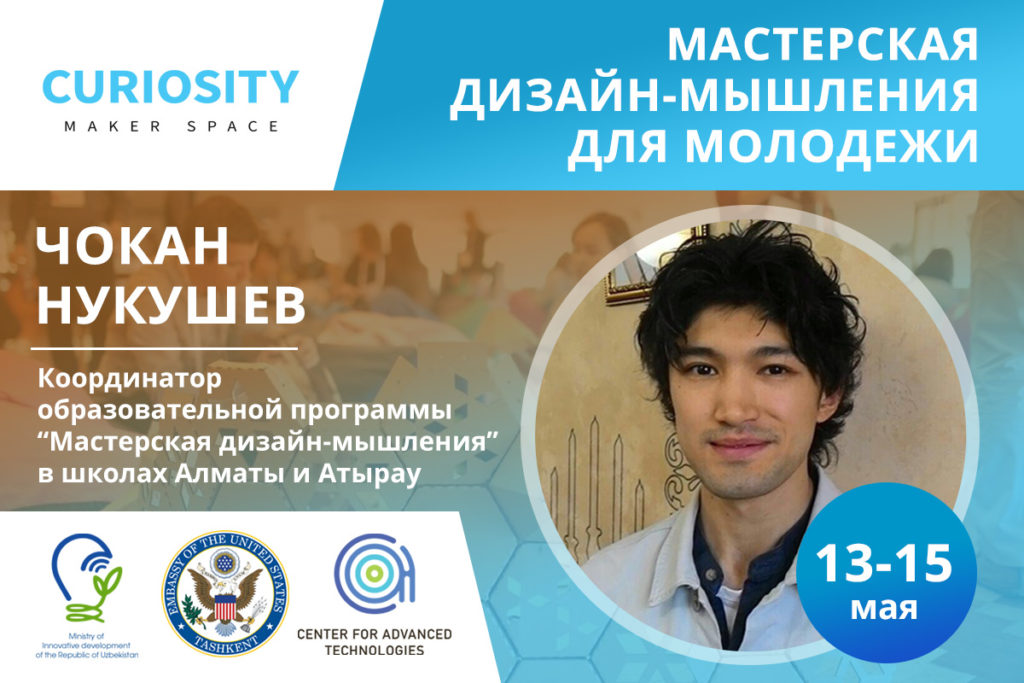17 May 2019
Master Class in Design Thinking for Youth
On May 13-15, as part of the Curiosity Maker Space project, we brought a high-class speaker on design thinking, and conducted a free 3-day course for teenagers (12-18 years old).
❗️ This is a very cool course. Our speaker is Chokan Nukushev, in the past — the country coordinator of the Social Impact Award international program of social entrepreneurship (the largest in Europe among youth), as well as the coordinator of the “Design-Thinking Workshop” educational program in schools in Almaty and Atyrau.
Participation is free of charge. The course was held at the Center for Advanced Technology.

_ _ _ _ _ _ _ _ _ _ _ _ _ _ _ _ _ _ _ _ _ _ _ _ _ _ _ _ _ _
Why do young people need design thinking? To develop curiosity, creativity, critical thinking skills and coming up with interesting solutions to various problem situations. No standard solutions like “we always did this way”…
The basis of the design thinking methodology (invented at Stanford University) is always a human (Human-Centered Design). In the course, the participants will learn how to come up with ideas not “just to tick the box”, but so that they can really help people. They will learn to find out what people need here and now, and they will learn to “turn” problems into opportunities.
_ _ _ _ _ _ _ _ _ _ _ _ _ _ _ _ _ _ _ _ _ _ _ _ _ _ _ _ _ _
The course program consists of 3 parts:
1⃣ Learn the basics of design thinking. What does design have to do with it? How to come up with non-standard ideas (+ homework)
2⃣ We study and research the audiences we want to help. How to conduct interrogation? How to read survey data? Learn to draw up mental maps for a better understanding of problems (+ homework)
3⃣ We work in groups, come up with solutions and make prototypes (+ homework)
_ _ _ _ _ _ _ _ _ _ _ _ _ _ _ _ _ _ _ _ _ _ _ _ _ _ _ _ _ _
On the first day of the master class, we explored the space around the Center for Advanced Technologies, learned to observe, notice something interesting.
_ _ _ _ _ _ _ _ _ _ _ _ _ _ _ _ _ _ _ _ _ _ _ _ _ _ _ _ _ _
On the 2nd day of the workshop, we printed out a map of the area and photographs taken by the participants on the 1st day of the workshop. All were divided into 4 groups, each of the groups had its own zone.
In each zone, what was liked/what could be improved was revealed and presented. And in the final they made a mental map of the area.
_ _ _ _ _ _ _ _ _ _ _ _ _ _ _ _ _ _ _ _ _ _ _ _ _ _ _ _ _ _
On the 3rd day of the master class, teams, for each of the 4 zones, formulated problems and came up with solutions to problems.
Then we went outside and conducted an interview, each team in its own zone, interviewing bypassers about what they like or dislike in each zone.
In the final of the master class, the participants combined their solutions with the solutions received from bypassers, and collectively, by voting, chose the most “hot” problems and the most interesting solutions.
In general, in 3 days, we learned the basic stages of design thinking: empathy (observation and understanding) / problem definition / generation of ideas and focus … We did not have time to prototype and test, but this was in the next master classes.
We thank our coach, Chokan Nukushev, for an excellent master class!
_ _ _ _ _ _ _ _ _ _ _ _ _ _ _ _ _ _ _ _ _ _ _ _ _ _ _ _ _ _
Curiosity Maker Space is supported by the Ministry of Inovative Development of Uzbekistan and the US Embassy.
Новости по теме